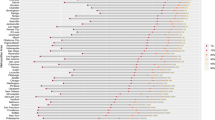Abstract
In this paper we present a route-level patronage model that incorporates transit demand, supply and inter-route effects in a simultaneous system. The model is estimated at the route-segment level by time of day and direction. The results show strong simultaneity among transit demand, supply and competing routes. Transit ridership is affected by the level of service, which in turn is determined by current demand and ridership in the previous year. The model demonstrates that a service improvement has a twofold impact on ridership; it increases ridership on the route with service changes, but it also reduces the ridership on competing routes so that the net ridership change is small. The model is thus useful for both system-level analysis and route-level service planning.
Similar content being viewed by others
References
Alperovich G, Kemp MA & Goodman KM (1977) An econometric model of bus transit demand and supply. The Urban Institute Working Paper No. 5032-1-4, Washington, D.C.
Cherwony W & Polin L (1977) Forecasting patronage on new transit routes. Traffic Quarterly: 287-195.
Gaudry M (1975) An aggregate time-series analysis of urban transit demand: the Montreal case. Transportation Research 9: 249-258.
Horowitz AJ (1984) Simplifications for single-route transit ridership forecasting models. Transportation 12: 261-275.
Horowitz AJ & Metzger DN (1985) Implementation of service area concepts in single-route ridership forecasting. Transportation Research Record 1037.
Judge GG, Griffiths WE, Hill RC, Lutkepohl H & Lee TC (1985) The Theory and Practice of Econometrics.New York: John Wiley and Sons.
Kyte M, Stoner GJ & Cryer J (1988) A time-series analysis of public transit ridership in Portland, Oregon, 1971-1982. Transportation Research-A 22: 345-59.
Menhard HR & Ruprecht GF (1983) Review of route-level ridership prediction techniques. Transportation Research Record 936.
Multisystems, Inc. (1982) Route-Level Demand Models: A Review.Urban Mass Transportation Administration, US Department of Transportation, DOT-1-82-6.
Peng Z (1994) A Simultaneous Route-level Transit Patronage Model: Demand, Supply, and Interroute Relationship.Ph.D. dissertation, Portland State University.
Peng, Z & Dueker JK (1995) Spatial data integration in route-level transit demand modeling. Journal of the Urban and Regional Information Systems Association 7: 26-37.
Peng Z & Dueker JK (1993) Error and accuracy in spatial data allocations. GIS/LIS 1993 Proceedings (pp. 592-602). Minneapolis.
Stopher PR (1992) Development of a route level patronage forecasting method. Transportation 19: 201-220.
Stopher PR & Mulhall S (1992) Route level patronage forecasting methods: a survey of transit operators. Presented at the 71st Annual Meeting, transportation Research Board, Washington, D.C.
Tri-Met (1989) Tri-Met Service Standards. Portland, Oregon, unpublished.
Author information
Authors and Affiliations
Rights and permissions
About this article
Cite this article
Peng, ZR., Dueker, K.J., Strathman, J. et al. A simultaneous route-level transit patronage model: demand, supply, and inter-route relationship. Transportation 24, 159–181 (1997). https://doi.org/10.1023/A:1017951902308
Issue Date:
DOI: https://doi.org/10.1023/A:1017951902308




